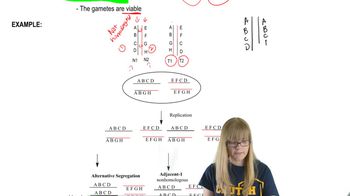Here are the essential concepts you must grasp in order to answer the question correctly.
Heterozygous Reciprocal Balanced Translocation
A heterozygous reciprocal balanced translocation occurs when two non-homologous chromosomes exchange segments, resulting in one chromosome carrying a segment from another. This type of translocation maintains genetic balance, as no genetic material is lost or gained. Understanding this concept is crucial for analyzing how chromosomes pair during meiosis, particularly in prophase I.
Recommended video:
Chromosome Pairing in Prophase I
During prophase I of meiosis, homologous chromosomes pair up in a process called synapsis, forming structures known as tetrads. This pairing is essential for genetic recombination and ensures proper segregation of chromosomes. In the context of a heterozygous translocation, the pairing may involve complex interactions between the translocated segments and their homologs.
Recommended video:
Meiotic Recombination
Meiotic recombination is the process by which genetic material is exchanged between homologous chromosomes during prophase I, leading to genetic diversity in gametes. This process can be influenced by structural variations like translocations, which may affect how chromosomes align and exchange segments. Understanding recombination is vital for predicting the genetic outcomes of meiosis in organisms with chromosomal abnormalities.
Recommended video:
Recombination after Single Strand Breaks
 Verified step by step guidance
Verified step by step guidance Verified video answer for a similar problem:
Verified video answer for a similar problem:



 12:42m
12:42m